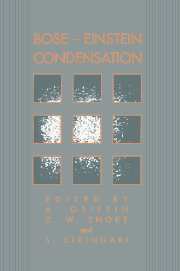Book contents
- Frontmatter
- Contents
- Preface
- Preface to paperback edition
- 1 Introduction: Unifying Themes of Bose–Einstein Condensation
- Part one Review Papers
- 2 Some Comments on Bose–Einstein Condensation
- 3 Bose–Einstein Condensation and Superfluidity
- 4 Bose-Einstein Condensation in Liquid Helium
- 5 Sum Rules and Bose–Einstein Condensation
- 6 Dilute-Degenerate Gases
- 7 Prospects for Bose–Einstein Condensation in Magnetically Trapped Atomic Hydrogen
- 8 Spin-Polarized Hydrogen: Prospects for Bose–Einstein Condensation and Two-Dimensional Superfluidity
- 9 Laser Cooling and Trapping of Neutral Atoms
- 10 Kinetics of Bose–Einstein Condensate Formation in an Interacting Bose Gas
- 11 Condensate Formation in a Bose Gas
- 12 Macroscopic Coherent States of Excitons in Semiconductors
- 13 Bose–Einstein Condensation of a Nearly Ideal Gas: Excitons in Cu2O
- 14 Bose–Einstein Condensation of Excitonic Particles in Semiconductors
- 15 Crossover from BCS Theory to Bose–Einstein Condensation
- 16 Bose–Einstein Condensation of Bipolarons in High-Tc Superconductors
- 17 The Bosonization Method in Nuclear Physics
- 18 Kaon Condensation in Dense Matter
- 19 Broken Gauge Symmetry in a Bose Condensate
- Part two Brief Reports
- Appendix. BEC 93 Participant List
- Index
5 - Sum Rules and Bose–Einstein Condensation
Published online by Cambridge University Press: 15 December 2009
- Frontmatter
- Contents
- Preface
- Preface to paperback edition
- 1 Introduction: Unifying Themes of Bose–Einstein Condensation
- Part one Review Papers
- 2 Some Comments on Bose–Einstein Condensation
- 3 Bose–Einstein Condensation and Superfluidity
- 4 Bose-Einstein Condensation in Liquid Helium
- 5 Sum Rules and Bose–Einstein Condensation
- 6 Dilute-Degenerate Gases
- 7 Prospects for Bose–Einstein Condensation in Magnetically Trapped Atomic Hydrogen
- 8 Spin-Polarized Hydrogen: Prospects for Bose–Einstein Condensation and Two-Dimensional Superfluidity
- 9 Laser Cooling and Trapping of Neutral Atoms
- 10 Kinetics of Bose–Einstein Condensate Formation in an Interacting Bose Gas
- 11 Condensate Formation in a Bose Gas
- 12 Macroscopic Coherent States of Excitons in Semiconductors
- 13 Bose–Einstein Condensation of a Nearly Ideal Gas: Excitons in Cu2O
- 14 Bose–Einstein Condensation of Excitonic Particles in Semiconductors
- 15 Crossover from BCS Theory to Bose–Einstein Condensation
- 16 Bose–Einstein Condensation of Bipolarons in High-Tc Superconductors
- 17 The Bosonization Method in Nuclear Physics
- 18 Kaon Condensation in Dense Matter
- 19 Broken Gauge Symmetry in a Bose Condensate
- Part two Brief Reports
- Appendix. BEC 93 Participant List
- Index
Summary
Abstract
Various sum rules, accounting for the coupling between density and particle excitations and emphasizing in an explicit way the role of Bose–Einstein condensation, are discussed. Important consequences on the fluctuations of the particle operator as well as on the structure of elementary excitations are reviewed. These include a recent generalization of the Hohenberg–Mermin–Wagner theorem holding at zero temperature.
Introduction
The sum rule approach has been employed extensively in the literature in order to explore various dynamic features of quantum many body systems from a microscopic point of view (see [1] and references therein). An important merit of the method is its explicit emphasis on the role of conservation laws and of the symmetries of the problem. Furthermore, the explicit determination of sum rules is relatively easy and often requires only a limited knowledge of the system. Usually the sum rule approach is, however, employed without giving special emphasis to the possible occurrence of (spontaneously) broken symmetries. For example, the most famous f-sum rule [2] holding for a large class of systems is not affected by the existence of an order parameter in the system.
The purpose of this paper is to discuss a different class of sum rules which are directly affected by the presence of a broken symmetry. These sum rules can be used to predict significant properties of the system which are the consequence of the existence of an order parameter.
- Type
- Chapter
- Information
- Bose-Einstein Condensation , pp. 86 - 98Publisher: Cambridge University PressPrint publication year: 1995
- 1
- Cited by



